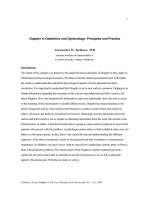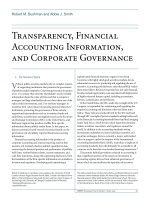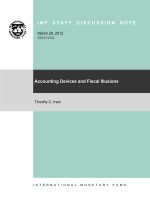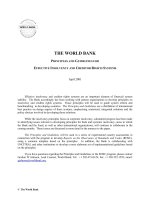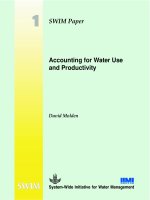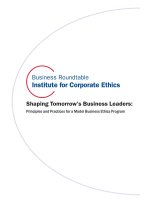Accounting Principles and Concepts ppt
Bạn đang xem bản rút gọn của tài liệu. Xem và tải ngay bản đầy đủ của tài liệu tại đây (2.68 MB, 65 trang )
Accounting Principles
and Concepts
Sharon Z. Weiss, Esq.
Professor David East, Esq.
Andrea Hartley, Esq.
Doneene Damon, Esq.
Chuck Carroll, CPA
Presented to: American Bar Association
April 10, 2008
2
Objectives
To provide a basic understanding of
Key accounting concepts
Financial statements (what are they?)
Financial statement analysis techniques
Regulatory governance
Auditor reports
Ratio analysis
Putting financial statements to use
Hot Topics (e.g., Sarbanes-Oxley)
3
Key Accounting Concepts
4
Accounting is the identification, measurement,
and communication of financial information about
economic entities to interested parties.
Source: Kieso, Donald E. and Jerry J. Weigandt, Intermediate Accounting.
Eighth Edition. 1995 NewYork: John Wiley & Sons
Accounting
What is Accounting?
5
Accounting
Key Concepts
Conservatism
Historical Cost Basis
Consistency
Substance Over Form
Going Concern
Materiality
Periodic Reporting
Accrual Basis
6
Accounting
Elements to Accounting Systems
• ASSETS
Resources with monetary value
• LIAIBILITIES
Creditors’ claims on assets
• OWNERS’ EQUITY
Owners’ and/or stockholders’ claims against assets
• REVENUES
Income from sales and other sources
• EXPENSES
Costs to company
7
Financial Statements
8
Financial Statements
Definition
“The term ‘financial statement’ refers to a
presentation of financial data, including
accompanying notes, derived from accounting
records and intended to communicate an entity’s
economic resources or obligations at a point in
time or the changes therein for a period of time in
conformity with a comprehensive basis of
accounting.”
Source: AICPA Codification of Statements on Auditing Standards, AU §623
9
Financial Statements
Primary SEC Filings for Public Companies
Form 10-K
• Contains annual financial
statements
• Must be audited
• Other company disclosures and
information
Form 10-Q
• Contains quarterly financial
statements
• Must be reviewed, not to form an
opinion, but to look for anomalies in
the data
• Other company disclosures and
information
10
Financial Statements
Overview of Financial Statements
Financial Accounting Standards Board (FASB) states that a full set
of financial statements should include:
• BALANCE SHEET
Financial position at the end of the period
• STATEMENT OF INCOME
Income for the period
• STATEMENT OF CASH FLOWS
Cash flows for the period
• STATEMENT OF CHANGES IN EQUITY
Investments by and distributions to owners during the period
• FOOTNOTES
Adequate disclosures to understand the financial statements
11
Financial Statements
Overview of Financial Statements
Beginning
Balance Sheet
January 1
Ending
Balance Sheet
December 31
Income Statement
for the Twelve Month Period
Statement of Cash Flows
for the Twelve Month Period
12
Financial Statements
Balance Sheet
Balance Sheet
($
amts in thousands
)
12
/
31
/
2000
Assets
C
urrent assets:
Cash
$
3,411
Marketable securities
$
2,333
Accounts Receivable, ne
t
$
4,464
Inventories
$
2,842
De
f
erred taxes on income
$
1,151
Deposits and prepaid expenses
$
1,249
Total current assets $15,450
Marketable securities
$
269
Property, plant, and equipmen
t
$
6,971
Intangible assets
$
7,256
Deferred taxes on income
$
54
Other assets, ne
t
$
1,321
Total assets $31,321
Liabilities and stockholders' equit
y
Current liabilities:
Accounts payable
$
2,083
Accrued liabilities
$
2,776
Loans and notes payable
$
1,479
Accrued salaries, wages and commissions
$
488
Taxes on income
$
314
Total current liabilities
$
7,140
Long-term deb
t
$
2,037
Deferred tax liabilit
y
$
255
Employee related obligations
$
1,753
Other liabilities $1,328
Total liabilities
$
12,513
Stockholders' equity:
C
ommon stock and paid-in capital
$
1,535
Note receivable
f
rom stock ownership plan
($
35
)
Accumulated other comprehensive income
($
470
)
Retained earnings
$
18,812
Less: common stock held in treasur
y
(
$
1,034)
Total stockholders' equity $18,808
Total liabilities and stockholders' equity
$31,321
Balance Sheet Objective:
• To provide reliable information about
a company’s economic resources and
obligations
• A snapshot of financial position at a
point in time
• Sometimes called the Statement of
Financial Position
Balance Sheet Equation:
Assets = Liabilities + Owners
Assets = Liabilities + Owners
’
’
Equity
Equity
*See handout
*See handout
“
“
Balance Sheet Components
Balance Sheet Components
”
”
for further details.
for further details.
13
Sales
-Cost of Sales
=Gross Profit
-Operating
Expenses
=Operating Profit
-Financing
Expenses
-Tax Expense
=Net Profit or
(Loss)
Sales
Gross profit
O,F, & T
expenses
Cost
of
sales
Net profit
Gross profit
Operating
expenses
Cost
of
sales
O, F, & T
expenses
Net loss
Sales
Financial Statements
Income Statement
14
Financial Statements
Income Statement
Income Statement
($ amts in thousands)
12/31/00
Sales Revenue
$29,139
Operating expenses:
Cost of goods sold ($8,861)
Gross Profit $20,278
Sales, marketing, and administrative expenses $10,875
Research expense $2,926
In-process research & development $54
Interest income ($379)
Interest expense $146
Other expense, net $67
Restructuring charge ($33)
$13,656
Earnings before provision for taxes on income $6,622
Provision for taxes on income $1,822
Net earnings (income) $4,800
Earnings per share:
Basic $3.45
Diluted $3.40
Income Statement Objective:
• To provide information about changes
in net resources that result from
business activities
• Reveals financial performance during
a specific period of time
• For public companies, earnings per
share will also be reported here
Income Statement Equation:
Revenues
Revenues
–
–
Expenses = Net Income
Expenses = Net Income
*See handout “Income Statement Components” for further details.
15
Financial Statements
Income Statement
$-
$0.50
$1.00
$1.50
$2.00
$2.50
1st
Qtr
2nd
Qtr
3rd
Qtr
4th
Qtr
1st
Qtr
EPS
Earnings per Share (EPS)
• Calculated by dividing Net
Income (Earnings) by shares of
common stock outstanding
• Small fluctuations in EPS may
have a large impact on stock
price
16
A Year in the Life of a Financial Statement
How Transactions Affect the Balance Sheet and Income Statement
Balance Sheet
Income Statement
TOTAL ASSETS
Property, Plant & Equipment
Accounts Receivable
Inventory
Cash
ASSETS
TOTAL LIABILITIES
Long-term Debt
Short-term Loans
Accounts Payable
LIABILITIES
TOTAL STOCKHOLDER EQUITY
Retained Earnings
Paid-in Capital
STOCKHOLDER EQUITY
PROFIT/(LOSS)
SG&A Expense
Cost of Goods Sold
Revenue
INCOME STATEMENT as of JAN 1
TOTAL LIABILITIES +
STOCKHOLDER EQUITY
How Do Balance Sheet and Income Statement
Reflect These Business Activities:
1. Start a New Business, deposit cash into
bank account
2. Spend money to acquire property,
equipment, inventory
3. Operate the business (fixed expenses);
Sell products for cash
How Do Balance Sheet and Income Statement
Reflect These Business Activities:
1. Start a New Business, deposit cash into
bank account
2. Spend money to acquire property,
equipment, inventory
3. Operate the business (fixed expenses);
Sell products for cash
17
A Year in the Life of a Financial Statement
How Transactions Affect the Balance Sheet and Income Statement
Balance Sheet
Income Statement
TOTAL ASSETS
Property, Plant & Equipment
Accounts Receivable
Inventory
Cash
ASSETS
TOTAL LIABILITIES
Long-term Debt
Short-term Loans
Accounts Payable
LIABILITIES
TOTAL STOCKHOLDER EQUITY
Retained Earnings
Paid-in Capital
STOCKHOLDER EQUITY
PROFIT/(LOSS)
SG&A Expense
Cost of Goods Sold
Revenue
INCOME STATEMENT as of JAN 1
TOTAL LIABILITIES +
STOCKHOLDER EQUITY
$1,000
$1,000
Step 1 (Jan 1
st
): Startup
Client Starts a New Business (“NewCo”)
Deposits $1,000 cash into NewCo bank account
Step 1 (Jan 1
st
): Startup
Client Starts a New Business (“NewCo”)
Deposits $1,000 cash into NewCo bank account
$1,000
$1,000
$1,000
$1,000
18
UPDATE INCOME
STATEMENT
UPDATE INCOME
STATEMENT
A Year in the Life of a Financial Statement
How Transactions Affect the Balance Sheet and Income Statement
Balance Sheet
Income Statement
TOTAL ASSETS
Property, Plant & Equipment
Accounts Receivable
Inventory
Cash
ASSETS
TOTAL LIABILITIES
Long-term Debt
Short-term Loans
Accounts Payable
LIABILITIES
TOTAL STOCKHOLDER EQUITY
Retained Earnings
Paid-in Capital
STOCKHOLDER EQUITY
PROFIT/(LOSS)
SG&A Expense
Cost of Goods Sold
Revenue
INCOME STATEMENT as of JAN 1
TOTAL LIABILITIES +
STOCKHOLDER EQUITY
$1,000
$1,000
$1,000
UPDATE TOTALS
UPDATE TOTALS
$0
$1,000
$1,000
$0
$0
$0
$0
THESE TOTALS
SHOULD MATCH
19
A Year in the Life of a Financial Statement
How Transactions Affect the Balance Sheet and Income Statement
Balance Sheet
Income Statement
TOTAL ASSETS
Property, Plant & Equipment
Accounts Receivable
Inventory
Cash
ASSETS
TOTAL LIABILITIES
Long-term Debt
Short-term Loans
Accounts Payable
LIABILITIES
TOTAL STOCKHOLDER EQUITY
Retained Earnings
Paid-in Capital
STOCKHOLDER EQUITY
PROFIT/(LOSS)
SG&A Expense
Cost of Goods Sold
Revenue
INCOME STATEMENT
TOTAL LIABILITIES +
STOCKHOLDER EQUITY
$1,000
$1,000
$1,000
$0
$1,000
$1,000
$0
$0
$0
$0
$5,000
$4,000
Step 2: Setting Up Shop
NewCo borrows $5,000 in long-term debt
Spends $4,000 on property, plant, and equipment
Spends $1,000 to purchase inventory
Step 2: Setting Up Shop
NewCo borrows $5,000 in long-term debt
Spends $4,000 on property, plant, and equipment
Spends $1,000 to purchase inventory
$4,000
$4,000
$5,000
$5,000
$1,000
$1,000
$1,000
20
A Year in the Life of a Financial Statement
How Transactions Affect the Balance Sheet and Income Statement
Balance Sheet
Income Statement
TOTAL ASSETS
Property, Plant & Equipment
Accounts Receivable
Inventory
Cash
ASSETS
TOTAL LIABILITIES
Long-term Debt
Short-term Loans
Accounts Payable
LIABILITIES
TOTAL STOCKHOLDER EQUITY
Retained Earnings
Paid-in Capital
STOCKHOLDER EQUITY
PROFIT/(LOSS)
SG&A Expense
Cost of Goods Sold
Revenue
INCOME STATEMENT
TOTAL LIABILITIES +
STOCKHOLDER EQUITY
$1,000
$1,000
$1,000
$0
$1,000
$1,000
$0
$0
$0
$0
$5,000
$4,000
$1,000
UPDATE TOTALS
UPDATE TOTALS
THESE TOTALS
SHOULD MATCH
$6,000
$5,000
$6,000
UPDATE INCOME
STATEMENT
(no change)
UPDATE INCOME
STATEMENT
(no change)
21
A Year in the Life of a Financial Statement
How Transactions Affect the Balance Sheet and Income Statement
Balance Sheet
Income Statement
TOTAL ASSETS
Property, Plant & Equipment
Accounts Receivable
Inventory
Cash
ASSETS
TOTAL LIABILITIES
Long-term Debt
Short-term Loans
Accounts Payable
LIABILITIES
TOTAL STOCKHOLDER EQUITY
Retained Earnings
Paid-in Capital
STOCKHOLDER EQUITY
PROFIT/(LOSS)
SG&A Expense
Cost of Goods Sold
Revenue
INCOME STATEMENT
TOTAL LIABILITIES +
STOCKHOLDER EQUITY
$1,000
$1,000
$1,000
$500
$200
$200
$100
$5,000
$4,000
$1,000
$5,000
$6,000
$6,000
Step 3: Doing Business
NewCo sells products totaling $500
Uses $200 in inventory (for goods sold)
Spends $200 on operating expenses
Step 3: Doing Business
NewCo sells products totaling $500
Uses $200 in inventory (for goods sold)
Spends $200 on operating expenses
$200
$200
$500
$500
$200
$200
UPDATE TOTAL
UPDATE TOTAL
22
A Year in the Life of a Financial Statement
How Transactions Affect the Balance Sheet and Income Statement
Balance Sheet
Income Statement
TOTAL ASSETS
Property, Plant & Equipment
Accounts Receivable
Inventory
Cash
ASSETS
TOTAL LIABILITIES
Long-term Debt
Short-term Loans
Accounts Payable
LIABILITIES
TOTAL STOCKHOLDER EQUITY
Retained Earnings
Paid-in Capital
STOCKHOLDER EQUITY
PROFIT/(LOSS)
SG&A Expense
Cost of Goods Sold
Revenue
INCOME STATEMENT
TOTAL LIABILITIES +
STOCKHOLDER EQUITY
$1,000
$1,000
$1,000
$500
$200
$200
$100
$5,000
$4,000
$1,000
$5,000
$6,000
$6,000
UPDATE BALANCE SHEET
CASH CHANGE: Revenue — Operating Expense = Change
($500 — $200) = $300 Increase
INVENTORY CHANGE: $200 Decrease
RETAINED EARNINGS: $100 Profit
UPDATE BALANCE SHEET
CASH CHANGE: Revenue — Operating Expense = Change
($500 — $200) = $300 Increase
INVENTORY CHANGE: $200 Decrease
RETAINED EARNINGS: $100 Profit
$300
$300
$200
$200
$100
$100
$1,300
$800
$100
23
A Year in the Life of a Financial Statement
How Transactions Affect the Balance Sheet and Income Statement
Balance Sheet
Income Statement
TOTAL ASSETS
Property, Plant & Equipment
Accounts Receivable
Inventory
Cash
ASSETS
TOTAL LIABILITIES
Long-term Debt
Short-term Loans
Accounts Payable
LIABILITIES
TOTAL STOCKHOLDER EQUITY
Retained Earnings
Paid-in Capital
STOCKHOLDER EQUITY
PROFIT/(LOSS)
SG&A Expense
Cost of Goods Sold
Revenue
INCOME STATEMENT as of Dec. 31
TOTAL LIABILITIES +
STOCKHOLDER EQUITY
$1,000
$1,000
$500
$200
$200
$100
$5,000
$4,000
$5,000
$6,000
$6,000
$1,300
$800
$100
UPDATE TOTALS
UPDATE TOTALS
THESE TOTALS
SHOULD MATCH
$6,100
$1,100
$6,100
24
BEGINNING CASH
ENDING CASH
Financial Statements
Statement of Cash Flows
25
Financial Statements
Statement of Cash Flows
Statement of Cash Flows
($ amts in thousands)
12/31/00
Operations
Net earnings
$ 4,800
Depreciation and amortization
1,515
In-process research and development
54
Increase in deferred taxes
(167)
Accounts receivable reserves
33
Increase in accounts receivable
(451)
Decrease (increase) in inventories
125
Accounts payable and accrued liabilities
57
Decrease in other current and non-current assets
143
Increase in other current and non-current liabilities
454
Net cash from operations 6,563
Investing
Additions to property, plant, and equipment
(1,646)
Proceeds from the disposal of assets
161
Acquisition of businesses, net of cash acquired
(68)
Purchases of investments
(5,383)
Sales of investments
4,670
Other
(102)
Net cash used for investing (2,368)
Financing
Dividends to shareholders
(1,724)
Repurchase of common stock
(973)
Proceeds from short-term debt
814
Retirement of short-term debt
(1,485)
Proceeds from long-term debt
4
Retirement of long-term debt
(28)
Proceeds from the exercise of stock options
292
Net cash used for financing (3,100)
Net change in cash and equivalents 1,095
Objective: To classify and report
cash receipts and payments.
Three Sections:
• Operating. Discloses the inflows
and outflows of cash due to
operations
• Investing. Discloses the inflows
and outflows of cash due to the
purchase and sales of PP&E and
other investment instruments
• Financing. Discloses the inflows
and outflows of cash due to the
retirement and receipt of debt
